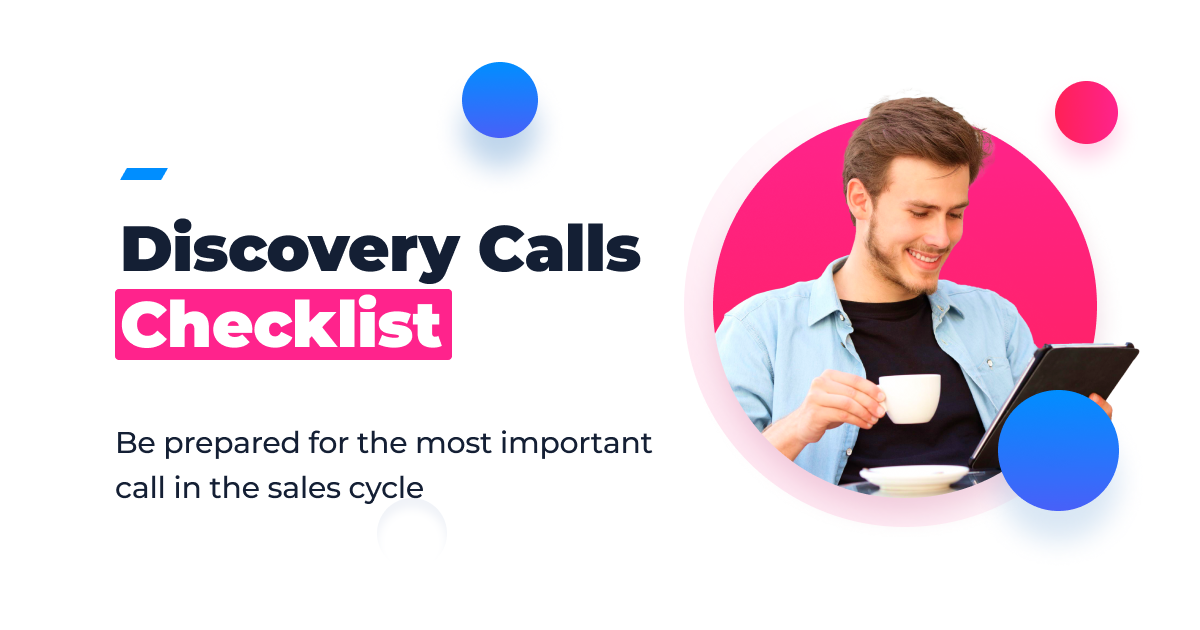The best place to start the sales process is at the beginning. Not only does it make identifying the next steps less complicated, but it also spares you of a Sisyphean task: you get a chance to drop leads that aren’t going to convert before you waste time on their nurture.
All that is possible thanks to sales discovery calls; the backbone of the selling process. No, really! Discovery calls have more impact on whether a deal closes or not than a closing call. So, it’s essential to nail those if you want to close more deals. Luckily for you, you came across this article.
Here, we’re talking about what a discovery call is, how to prepare for one, which questions to ask at each stage of the discovery call. Moreover, we also share the best tips and tricks for increasing your discovery call success.
Download our Sales Discovery Calls Checklist to make sure you don’t forget the main tips and tricks we share in this article.
What is a sales discovery call?
A sales discovery call is the first one-on-one interaction a sales representative has with a prospect after connecting with them. It’s one of the most important calls salespeople have, and here’s why…
- They qualify prospects and find whether they fit your business’s Ideal Customer Profile (ICP). As you better understand which prospects have a better chance of turning into high-value customers, you can prioritise your workload accordingly.
- They outline the relationship between the salesperson and the prospect. You can use this interaction as an opportunity to establish yourself as a trustworthy, knowledgeable business that wants its customer to succeed.
- They help sales reps define the sales process. They give a better understanding of what to focus on at the demo call, the content to share, etc.
How do I prepare for a sales discovery call?
There’s a lot at stake. Whether your discovery call is successful determines the subsequent fate of any prospective deal. You can’t dive head-first into the call; you don’t want to miss a profitable opportunity because you’re underprepared. You should do some groundwork before picking up the phone.
The preparation process can be divided into two parts, both of which are equally important - research and planning.
Conduct preliminary research
If you want to come across as a knowledgeable vendor that has enough expertise to solve the prospect’s pain points, you need to anticipate those before your prospect states their needs out loud themselves. You need to predict which questions are relevant to a prospect, prompting them to speak to keep the conversation going.
Luckily, there are several ways to dig for information about your prospect’s company...
Website
A prospect’s company website is a goldmine of information about the business. Here are things that different pages of your prospect’s website tell about their business.
- About Us section offers general information about a prospect’s company; their leadership, or investors that may influence the prospect’s purchasing decision.
- Customer success stories page tells you more about the clients that work with your prospect, outlining what your prospect’s company is good at.
- Careers section gives you an opportunity to find out which departments within the company are understaffed; to identify acute pain points.
- News section unearths information about the company’s recent updates, launches, funding, and ambition available to a prospect.
LinkedIn is a fantastic source of information about prospects because it’s up to date and detailed. You can learn a lot about your prospect by checking out the following sections of their LinkedIn profile.
- About. This section provides you with the boiled-down version of the prospect’s biography and tells you more about who they are, their strengths and focusses.
- Posts. Look through your prospect’s LinkedIn posts and other activities (likes, comments) to learn what’s top-of-mind at the company these days.
The best thing about LinkedIn is that you can automate the data scraping process and make discovery call preparation more productive. Make use of NetHunt’s CRM integration with LinkedIn to automatically extract all the data publicly available on your prospect’s LinkedIn profile and have the system form a neat CRM record in a single click.
Once the LinkedIn user is already in your CRM system, you’ll have all their information available on the sidebar for quick access anytime you’re browsing LinkedIn.
Download NetHunt’s LinkedIn integration here!
Your CRM data
Finally, take a look at the CRM record of your prospect and see where they are in their buyer’s journey. Every minor detail matters, as they can tell you more about your prospect’s pain points and needs. The following things tend to be the most eloquent when it comes to positioning a prospect in the sales cycle.
- Which resources they’ve downloaded.
- What you’ve discussed in previous email conversations.
- Which links they’ve clicked on.
- What content you’ve already shared with them.
- Whether or not they’ve already shared their pain points with you.
Plan your discovery call
Once you have all the necessary information on your hands, it’s time to move onto the next stage of the discovery call preparations - planning. Here are the key things you need to do when planning a discovery call.
Create a mind map with all the facts you found out about your prospect from the pre-call research. You need to structure all the information about the prospect to see patterns, threats and opportunities. This will help you match your questions with the prospect’s specific situation and make the call more relevant and productive.
Source: Created for free, using MindMup
Set the agenda for your discovery call. Think about what you want to accomplish with a call and build your conversation around that. Choose the appropriate script for your discovery call based on the things you plan to discuss.
Write down three specific situational questions that will help you identify your prospect’s needs. Come up with three core things you’re going to discuss with the prospect - then, think of smaller questions that elaborate on the subject.
Prepare your resources to the same end. If you’re planning to share a marketing deck or host a demo, test-run everything to make sure it works properly.

The structure of discovery calls and discovery call questions
You don’t need to reinvent the wheel. The formula of an ideal discovery call has been around for a while now. Every successful discovery call is based on the SPIN selling model. According to this selling model, every discovery conversation can be broken down into four stages. Successful completion allows salespeople to guarantee a second call and bring a more realistic chance of eventual conversion.
- Situation. Sales reps test the waters and ask qualifying questions. This helps them learn more about the business workflows in their prospect’s respective companies and uncover the background behind their current solution.
- Problem. Sales reps ask straightforward and open-ended questions about the struggles a prospect’s business faces, to identify their needs and pain points.
- Implication. Sales reps reflect on the information they learn about the prospect’s business problem and ask implication questions to make the potential customer realise how this problem can affect their business without explicitly stating the adverse consequences of leaving things unattended.
- Need-payoff. Sales reps ask suggestive questions that lead prospects to realisation of the benefits of the offered solution.
Step 1: Qualification
Thanks to the pre-discovery call research, you should already have a good idea of who you’re talking to.
You can start a discovery call with a generic qualifying question to find out more about how things work internally. Not only will it help you have a better understanding of where to direct the subsequent conversation, but it also acts as a great icebreaker that loosens the prospect’s tongue.
- Tell me about your company.
- What does your daily business routine look like?
- How do you measure performance?
- What does success look like to you?
Next, your goal is to understand what challenges your prospects face as well as what goals they hope to achieve. Here are the qualification questions to ask at this stage of the discovery call.
- What are your company’s main strengths and weaknesses?
- Have you already tried to solve any issues?
- Why have you chosen to solve this problem now?
- How has your business changed since [event]?
- What are the top priorities for your business?
- How much of an impact does [problem] have on your business?
- Where will your business be if you ignore [problem] now?
- What solution do you use for [problem]? Are you satisfied?
- What is your ideal outcome for [problem]?
Better safe than sorry, right? A discovery call is your opportunity to identify all the possible roadblocks during the early stages with a prospect. It makes a lot of sense to play it safe and ask a couple of disqualifying questions, too. Just to make sure you’re not wasting time on someone who’s not going to convert into a paying customer at the end of the day. Here are the examples of disqualifiers you can ask your prospects at the qualification stage.
- What roadblocks do you face in implementing this solution?
- What is your timeline for implementing a solution?
- Does your team find this offer relevant to their workflows?
- Is there a budget available for our solution?
Step 2: Identification of pain points
It’s the salesperson’s job to unearth underlying causes of any challenges a prospect has. The trick here is to not blame a prospect for the situation they are currently in. That means it’s best to avoid stating any pain points explicitly. Instead, you should ask open-ended, negatively-faced questions, which will get them to arrive at their pain points independently.
It will help the prospect see the value your solution holds more clearly. Here are a couple of examples of such questions.
- How effective do you think your current solutions for [problem] is?
- What’s the biggest challenge your company is facing now?
- What factors can hinder your business growth and stop you from achieving your goals?
- What happens if you fail to solve [problem]?
- If you have face issues with your current solution for [problem], will you be able to solve it quickly and efficiently?
- How important is it to quickly solve the problematic issue with your current solution?
Step 3: Intensification of pain points
The next step of a discovery call is the cruellest. Here, you intensify your prospect’s pain and play on their fear of failure. This allows you to create a sense of urgency and prompt the prospect to take the next steps.
You need to visualise the consequences of their problems for them, explaining how serious the situation is. Make them think about what will happen to their business, if they don’t find a viable solution ASAP.
Ask some suggestive questions and let your prospect’s imagination do the rest. Below are some basic implication questions that can help you amplify your prospect’s pain points.
- How much money are you losing to [problem]?
- How many opportunities have you missed because of [problem]?
- How is [problem] impacting your team spirit?
- How disappointing will it be if you don’t meet your goals this year?
Step 4: Be optimistic
No matter how severe their current situation is, there’s always a way out - always. You need to create this positive vision and pitch your product/service as the solution. Use this as an opportunity to practice value-based selling and link the features of your offer with their needs. Here are some questions to add to your script.
- If you could [feature benefit], how would it change your company’s workflows?
- If you could [feature benefit], how much closer would it bring your team to achieving your goals?
- If you could [feature benefit], how much money would it spare to spend on other important projects?
- Would it be better for your team if [problem] was no longer a problem?
- What would it mean for your business to be able to resolve [problem]?
Step 5: And the rest...
There’s one more thing you need to do before ending the call. We should discuss the next steps and give your prospects a clear CTA, so they know in which direction to move towards. Then, thank your prospect for their time and the answers they’ve given to you and schedule your next interaction.
- What would make this process easier—how can I help?
- Is there anyone else involved in the decision-making process?
- If I can help you do [feature benefit], what other factors have an impact on the deal?
- Based on what you’ve told me today, I’d recommend [problem].
Tips for successful discovery call in sales
If you follow the SPIN structure, you’re already doing better than your competitors by bringing order to your discovery call. However, you can make the call even more productive and successful by implementing the following tips.
Don’t ask too few or too many questions
According to Gong, you’re most likely to nail your initial conversation when you ask between 11 to 14 targeted questions, if you’re talking to a middle manager. If you’re on the phone with a C-Suite executive, the number of questions you can ask is even smaller. They are pressed for time, so the appropriate number of C-Suite questions ranges between 4 to 8 high-quality hits.
Similarly, your questions don’t have to jump from one problem to another. It’s best to limit the number of problems you discuss within the framework of a single call to 3 to 4 issues.
Match discovery call questions to the prospect’s journey
Your goal isn’t to make the call last as long as possible. Instead, you seek to establish a meaningful connection with the prospect and nudge them towards the desired next steps.
That’s only possible when you (a) know what the next steps are and (b) you can orchestrate the conversation in such a way that it naturally arrives at conversion.
You need to talk about the things that are relevant to your prospect at that precise moment. That way, you don’t annoy them and present yourself as a competent professional that knows what their prospects are going through.
For example...
if you know that your prospect is actively evaluating solutions like yours, don’t start the conversation with diagnostic questions. They’ve already discovered their pain points and realised their need. Hence, you should go straight for situation-specific questions…
NOT... "What’s your biggest strategic priority for this year?" BUT… "What do you hope to achieve by implementing our solution?"
Spread questions evenly throughout the call
It’s not just the number of questions you ask that matters, but also their order and density. There are stats to suggest that sales reps that spread their questions evenly throughout the call achieve better discovery call results than those that front-load all the questions.
Source: Gong
Ask open-ended questions
You should refrain from asking questions that can be answered with a simple ‘yes’ or ‘no’ - they’re not very informative and don’t put things into perspective. Instead, you should prompt a conversation with natural flow. There should be a change of speakers every couple of minutes, and the prospect should do the majority of talking.
- How would X impact your business workflows?
- Please describe your perfect outcome for X.
- How do you plan to achieve your sales goals this year?
Pause for thought
Although it sounds counterintuitive, one of the most effective ways to get the conversation flowing is to shut up at the appropriate moment. If you feel like your discovery call is one-sided with you doing the majority of talking, make a pause and create an awkward silence. It’s a basic human instinct to fill those silences in, so they’ll feel the need to talk.
Practice active listening
A couple of effective active listening techniques can improve the success of your discovery calls, increasing your chances of a closed deal…
- Don’t interrupt. Make sure you let your prospect finish their sentence and clearly communicate their idea. Make note of a thought and wait your turn.
- Paraphrase what’s been said. Show your prospect that you understand what they mean: ‘In other words, what you’re saying is…’
- Name their emotions. Make the conversation more personal by appealing to your prospect’s emotions. Label their emotions using the following phrases: ‘It seems like you…’, ‘It sounds like you…’, ‘It looks like you…’.
- Mirror your prospect. Try to use the same language and say your prospect’s last 2-4 words back to them as a question.
Record all the details of your discovery call in CRM
You need to understand that a discovery call isn’t a self-standing event, but rather a part of a much bigger sales process. You need to record every detail of your call in your CRM system so that you can use it in the future. It helps to address their challenges and create perfect (automated) follow-up sequences. Create separate, required fields that will be the same for all prospects for standardised data on your whole lead and customer database.
CRM information helps a lot during pipeline review meetings. It allows us to analyse the sales team’s performance and ensure that sales reps target the right client profile. Alternatively, you can use it to justify a new buying segment, if you see a decent number of prospects with the same parameters different from your ICP.
Check out our piece on how to use sales call recording to improve the sales process.
Thank you for calling. NetHunt over and out!
Table of Contents
Crack the sales formula with CRM Lab
Twice a month, receive actionable CRM content to your inbox.






